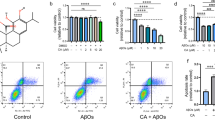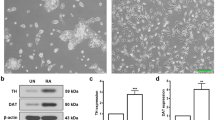Abstract
Although the etiology of Alzheimer’s disease (AD) is not fully understood, multiple lines of evidence suggests the importance of amyloid-β (Aβ) in the initiation/progression of the disease. Aβ has been shown to induce neuronal apoptosis via the sphingomyelin/ceramide pathway. This study was designed to elucidate whether the sphingosine kinase-1 (SPK1), a critical regulator of the ceramide/sphingosine 1-phosphate rheostat, plays a pivotal role in the regulation of death and survival of differentiated neuro-2a cells in response to beta-amyloid peptide fragment 25–35 (Aβ25–35). These results show that the expression of SPK1 was markedly decreased in Aβ25–35-induced neurotoxicity, as evidenced by the decreased cell viability and the increased apoptotic rate. Overexpression of SPK1 significantly attenuated Aβ25–35-induced neurotoxicity, whereas silencing the expression of SPK1 exacerbated it. Moreover, overexpression of SPK1 can significantly attenuate Aβ25–35-induced upregulation of Bax and rehabilitate the level of Bcl-2; concomitantly, it can ameliorate mitochondrial ultrastructure. These studies demonstrate that overexpression of SPK1 may moderate Aβ25–35-induced neurotoxicity by regulating the Bcl-2/Bax ratio and improving mitochondrial ultrastructure. Based on these findings, SPK1 is a potential therapeutic target for AD.




Similar content being viewed by others
References
Ogretmen B, Hannun YA (2004) Biologically active sphingolipids in cancer pathogenesis and treatment. Nat Rev Cancer 4(8):604–616
Spiegel S, Milstien S (2003) Sphingosine-1-phosphate: an enigmatic signalling lipid. Nat Rev Mol Cell Biol 4(5):397–407
Cuvillier O, Pirianov G, Kleuser B, Vanek PG, Coso OA, Gutkind S, Spiegel S (1996) Suppression of ceramide-mediated programmed cell death by sphingosine-1-phosphate. Nature 381(6585):800–803
Grace EA, Rabiner CA, Busciglio J (2002) Characterization of neuronal dystrophy induced by fibrillar amyloid beta: implications for Alzheimer’s disease. Neuroscience 114(1):265–273
Jarvis K, Assis-Nascimento P, Mudd LM, Montague JR (2007) Beta-amyloid toxicity and reversal in embryonic rat septal neurons. Neurosci Lett 423(3):184–188
Gomez-Brouchet A, Pchejetski D, Brizuela L, Garcia V, Altie MF, Maddelein ML, Delisle MB, Cuvillier O (2007) Critical role for sphingosine kinase-1 in regulating survival of neuroblastoma cells exposed to amyloid-beta peptide. Mol Pharmacol 72(2):341–349
McNamara W (1975) Exorcising HEW. Change 7(7):47–48, 63
Smale G, Nichols NR, Brady DR, Finch CE, Horton WE Jr (1995) Evidence for apoptotic cell death in Alzheimer’s disease. Exp Neurol 133(2):225–230
He X, Huang Y, Li B, Gong CX, Schuchman EH (2010) Deregulation of sphingolipid metabolism in Alzheimer’s disease. Neurobiol Aging 31(3):398–408
Satoi H, Tomimoto H, Ohtani R, Kitano T, Kondo T, Watanabe M, Oka N, Akiguchi I, Furuya S, Hirabayashi Y, Okazaki T (2005) Astroglial expression of ceramide in Alzheimer’s disease brains: a role during neuronal apoptosis. Neuroscience 130(3):657–666
Jana A, Pahan K (2004) Fibrillar amyloid-beta peptides kill human primary neurons via NADPH oxidase-mediated activation of neutral sphingomyelinase. Implications for Alzheimer’s disease. J Biol Chem 279(49):51451–51459
Ju TC, Chen SD, Liu CC, Yang DI (2005) Protective effects of S-nitrosoglutathione against amyloid beta-peptide neurotoxicity. Free Radic Biol Med 38(7):938–949
Malaplate-Armand C, Florent-Bechard S, Youssef I, Koziel V, Sponne I, Kriem B, Leininger-Muller B, Olivier JL, Oster T, Pillot T (2006) Soluble oligomers of amyloid-beta peptide induce neuronal apoptosis by activating a cPLA2-dependent sphingomyelinase-ceramide pathway. Neurobiol Dis 23(1):178–189
Lee JT, Xu J, Lee JM, Ku G, Han X, Yang DI, Chen S, Hsu CY (2004) Amyloid-beta peptide induces oligodendrocyte death by activating the neutral sphingomyelinase-ceramide pathway. J Cell Biol 164(1):123–131
Ayasolla K, Khan M, Singh AK, Singh I (2004) Inflammatory mediator and beta-amyloid (25–35)-induced ceramide generation and iNOS expression are inhibited by vitamin E. Free Radic Biol Med 37(3):325–338
Alessenko AV, Bugrova AE, Dudnik LB (2004) Connection of lipid peroxide oxidation with the sphingomyelin pathway in the development of Alzheimer’s disease. Biochem Soc Trans 32(Pt 1):144–146
Olivera A, Kohama T, Edsall L, Nava V, Cuvillier O, Poulton S, Spiegel S (1999) Sphingosine kinase expression increases intracellular sphingosine-1-phosphate and promotes cell growth and survival. J Cell Biol 147(3):545–558
Edsall LC, Cuvillier O, Twitty S, Spiegel S, Milstien S (2001) Sphingosine kinase expression regulates apoptosis and caspase activation in PC12 cells. J Neurochem 76(5):1573–1584
Pchejetski D, Golzio M, Bonhoure E, Calvet C, Doumerc N, Garcia V, Mazerolles C, Rischmann P, Teissie J, Malavaud B, Cuvillier O (2005) Sphingosine kinase-1 as a chemotherapy sensor in prostate adenocarcinoma cell and mouse models. Cancer Res 65(24):11667–11675
Duan HF, Wang H, Yi J, Liu HJ, Zhang QW, Li LB, Zhang T, Lu Y, Wu CT, Wang LS (2007) Adenoviral gene transfer of sphingosine kinase 1 protects heart against ischemia/reperfusion-induced injury and attenuates its postischemic failure. Hum Gene Ther 18(11):1119–1128
Bligh EG, Dyer WJ (1959) A rapid method of total lipid extraction and purification. Can J Biochem Physiol 37(8):911–917
St-Laurent-Thibault C, Arseneault M, Longpre F, Ramassamy C (2011) Tyrosol and hydroxytyrosol, two main components of olive oil, protect N2a cells against amyloid-beta-induced toxicity. Involvement of the NF-kappaB signaling. Curr Alzheimer Res 8(5):543–551
Manczak M, Mao P, Calkins MJ, Cornea A, Reddy AP, Murphy MP, Szeto HH, Park B, Reddy PH (2010) Mitochondria-targeted antioxidants protect against amyloid-beta toxicity in Alzheimer’s disease neurons. J Alzheimers Dis 20(Suppl 2):S609–S631
Yankner BA (1996) Mechanisms of neuronal degeneration in Alzheimer’s disease. Neuron 16(5):921–932
Yankner BA, Dawes LR, Fisher S, Villa-Komaroff L, Oster-Granite ML, Neve RL (1989) Neurotoxicity of a fragment of the amyloid precursor associated with Alzheimer’s disease. Science 245(4916):417–420
Millucci L, Ghezzi L, Bernardini G, Santucci A (2010) Conformations and biological activities of amyloid beta peptide 25–35. Curr Protein Pept Sci 11(1):54–67
Ban JY, Cho SO, Jeon SY, Bae K, Song KS, Seong YH (2007) 3,4-Dihydroxybenzoic acid from Smilacis chinae rhizome protects amyloid beta protein (25–35)-induced neurotoxicity in cultured rat cortical neurons. Neurosci Lett 420(2):184–188
Qin XY, Cheng Y, Cui J, Zhang Y, Yu LC (2009) Potential protection of curcumin against amyloid beta-induced toxicity on cultured rat prefrontal cortical neurons. Neurosci Lett 463(2):158–161
Paradis E, Douillard H, Koutroumanis M, Goodyer C, LeBlanc A (1996) Amyloid beta peptide of Alzheimer’s disease downregulates Bcl-2 and upregulates Bax expression in human neurons. J Neurosci 16(23):7533–7539
Tortosa A, Lopez E, Ferrer I (1998) Bcl-2 and Bax protein expression in Alzheimer’s disease. Acta Neuropathol 95(4):407–412
Limaye V, Li X, Hahn C, Xia P, Berndt MC, Vadas MA, Gamble JR (2005) Sphingosine kinase-1 enhances endothelial cell survival through a PECAM-1-dependent activation of PI-3 K/Akt and regulation of Bcl-2 family members. Blood 105(8):3169–3177
Green DR, Reed JC (1998) Mitochondria and apoptosis. Science 281(5381):1309–1312
Borner C (2003) The Bcl-2 protein family: sensors and checkpoints for life-or-death decisions. Mol Immunol 39(11):615–647
Selznick LA, Zheng TS, Flavell RA, Rakic P, Roth KA (2000) Amyloid beta-induced neuronal death is Bax-dependent but caspase-independent. J Neuropathol Exp Neurol 59(4):271–279
Yao M, Nguyen TV, Pike CJ (2005) Beta-amyloid-induced neuronal apoptosis involves c-Jun N-terminal kinase-dependent downregulation of Bcl-w. J Neurosci 25(5):1149–1158
Acknowledgments
This project was supported by the Chinese National Science Foundation (81070879). We thank Dr. Haifeng Duan (Department of Experimental Hematology, Beijing Institute of Radiation Medicine) for the plasmids encoding wild-type hSPK1.
Conflict of interest
The authors declare that there are no conflicts of interest.
Author information
Authors and Affiliations
Corresponding author
Rights and permissions
About this article
Cite this article
Yang, Y., Wang, M., Lv, B. et al. Sphingosine Kinase-1 Protects Differentiated N2a Cells Against Beta-Amyloid25–35-Induced Neurotoxicity Via the Mitochondrial Pathway. Neurochem Res 39, 932–940 (2014). https://doi.org/10.1007/s11064-014-1290-6
Received:
Revised:
Accepted:
Published:
Issue Date:
DOI: https://doi.org/10.1007/s11064-014-1290-6




